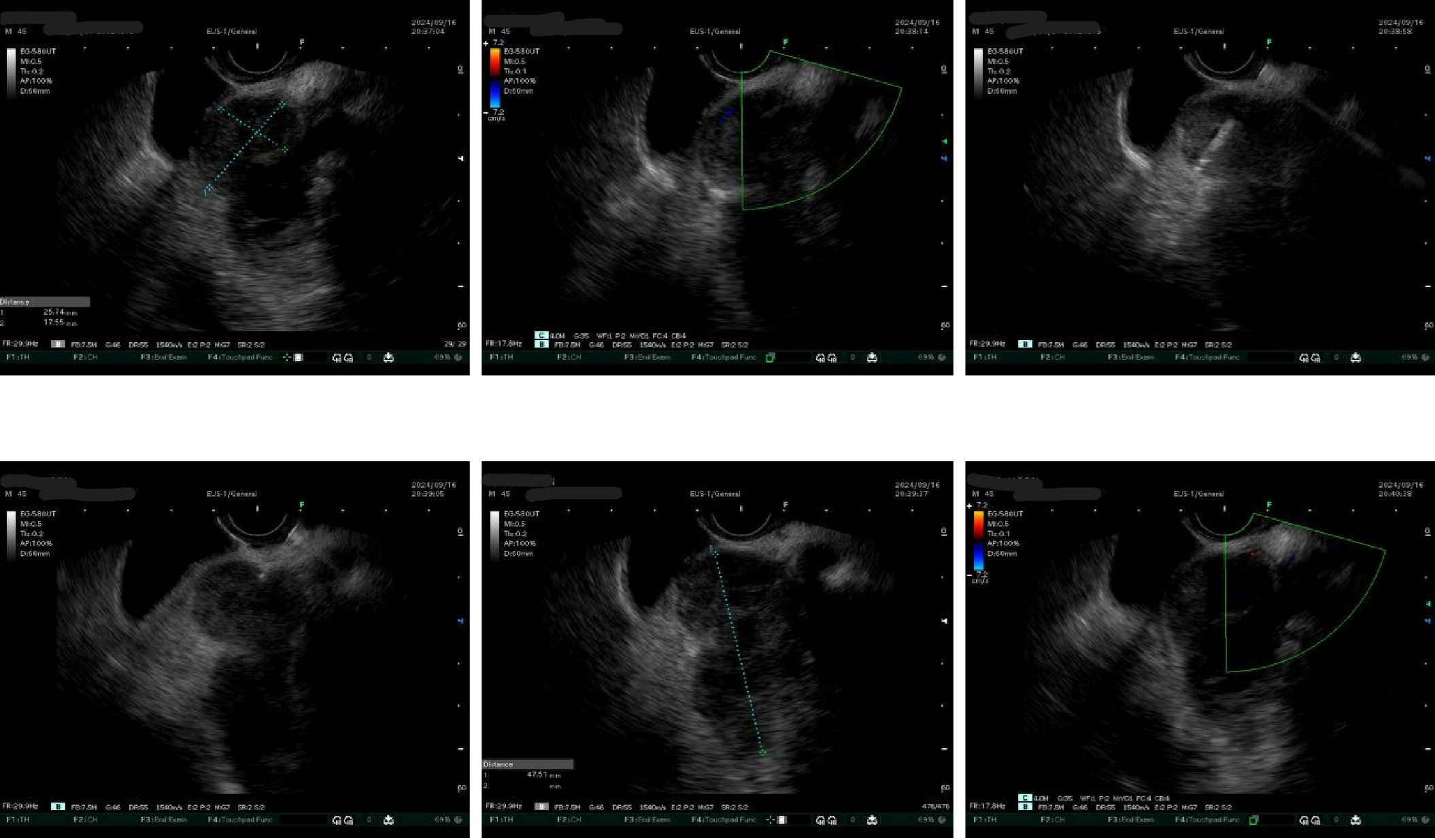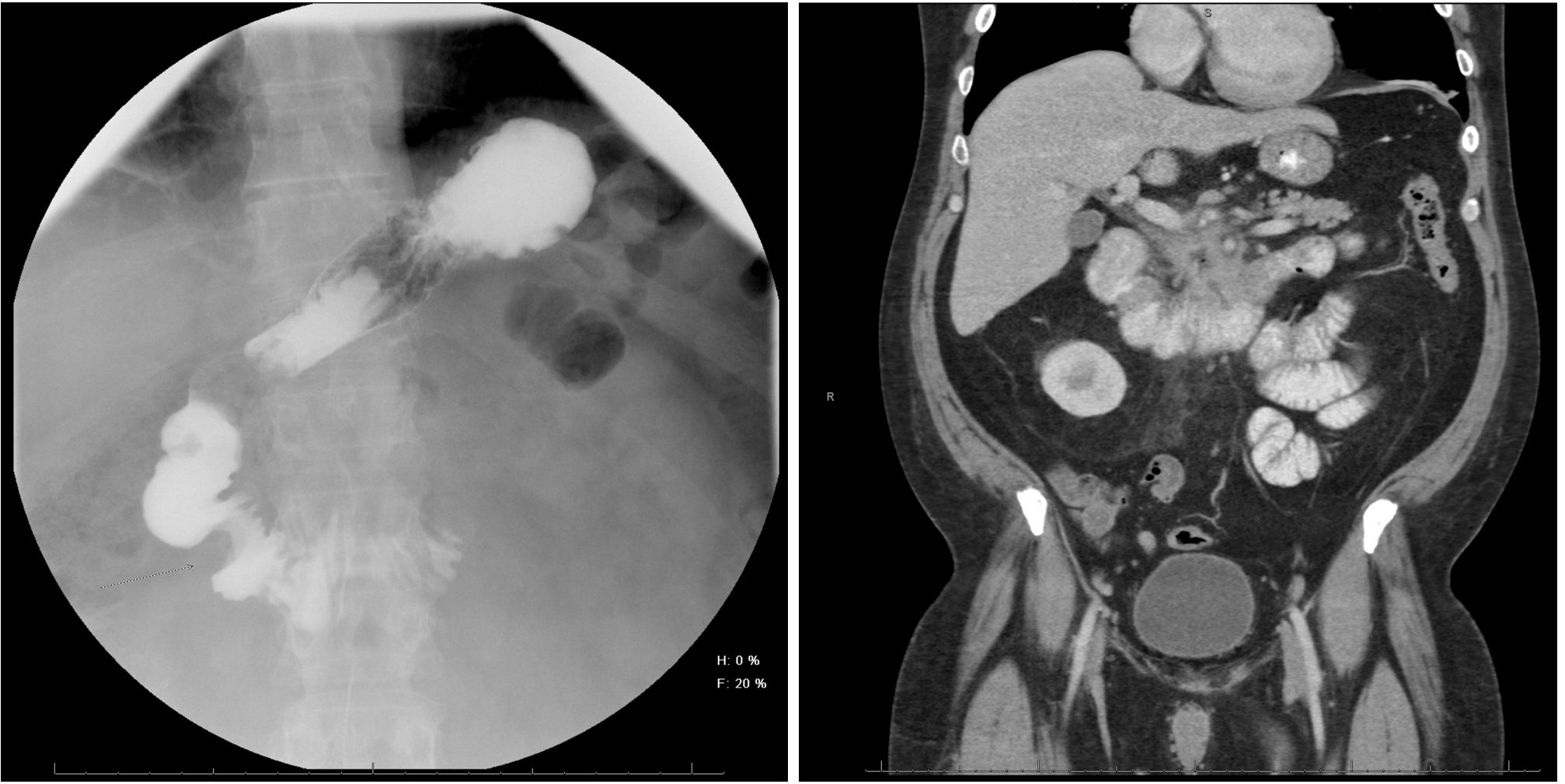Tuesday Poster Session
Category: Biliary/Pancreas
P4403 - Annular Pancreas Unveiled: An Incidental Finding in Alcoholic Pancreatitis
Tuesday, October 28, 2025
10:30 AM - 4:00 PM PDT
Location: Exhibit Hall

Wilhelm Basegoda, MD (he/him/his)
University of South Alabama
Mobile, AL
Presenting Author(s)
Wilhelm Basegoda, MD1, Jessica E. Woodham, DO1, Mason Adams, MD2
1University of South Alabama, Mobile, AL; 2USA Health, University of South Alabama, Mobile, AL
Introduction: Gastroenterologists often evaluate pancreatic fluid collections following episodes of acute pancreatitis. Although most collections self-resolve, there are cases where endoscopic or surgical intervention is required. We present a case of an incidentally discovered annular pancreas during the evaluation of a pancreatic fluid collection in a patient with alcoholic pancreatitis.
Case Description/
Methods: A 45-year-old male with recurrent pancreatitis and alcohol use was transferred for evaluation of a growing pancreatic lesion and weight loss. Previously hospitalized twice for pancreatitis, he presented with severe abdominal pain and vomiting. Examination exhibited tenderness in the epigastric region. Laboratory findings revealed mild leukocytosis (WBC 10.9) and elevated alkaline phosphatase (156 U/L). Imaging suggested a hemorrhagic pancreatic pseudocyst with surrounding inflammatory changes encasing a portion of the superior mesenteric artery (SMA) and a short segment of the right common hepatic artery, with significant regional lymphadenopathy. Upper endoscopy and endoscopic ultrasound (EUS) revealed a duodenal stricture and an unorganized pancreatic collection containing hyperechoic components and diffuse inflammation. A biopsy and aspiration of the unorganized lesion were negative for malignancy. Despite dietary modification, the patient continued to experience persistent abdominal pain and significant weight loss at outpatient follow-up. Repeat imaging demonstrated decreased fluid collection and inflammation, suggesting resolution of pancreatitis but revealed an annular pancreas encircling the duodenum and SMA. An upper gastrointestinal series confirmed the presence of a duodenal stricture. The patient subsequently underwent a gastrojejunostomy and reported significant symptomatic improvement, tapering off pain medications, and resuming a regular diet.
Discussion: Most fluid collections following acute pancreatitis are benign and resolve without intervention. However, when symptoms fail to improve, a broad differential diagnosis is important. Annular pancreas is a rare congenital anomaly with an estimated prevalence of 0.0045% in the general population. While it is typically diagnosed in childhood, it may remain undetected until adulthood. This case demonstrates a rare incidental finding ultimately requiring surgical intervention and highlights the importance of considering annular pancreas as a differential diagnosis.

Figure: Figure 1. EUS demonstrating the fluid collection

Figure: Figure 2. GI series highlighting the duodenal stricture and CT scan demonstrating the annular pancreas.
Disclosures:
Wilhelm Basegoda indicated no relevant financial relationships.
Jessica Woodham indicated no relevant financial relationships.
Mason Adams indicated no relevant financial relationships.
Wilhelm Basegoda, MD1, Jessica E. Woodham, DO1, Mason Adams, MD2. P4403 - Annular Pancreas Unveiled: An Incidental Finding in Alcoholic Pancreatitis, ACG 2025 Annual Scientific Meeting Abstracts. Phoenix, AZ: American College of Gastroenterology.
1University of South Alabama, Mobile, AL; 2USA Health, University of South Alabama, Mobile, AL
Introduction: Gastroenterologists often evaluate pancreatic fluid collections following episodes of acute pancreatitis. Although most collections self-resolve, there are cases where endoscopic or surgical intervention is required. We present a case of an incidentally discovered annular pancreas during the evaluation of a pancreatic fluid collection in a patient with alcoholic pancreatitis.
Case Description/
Methods: A 45-year-old male with recurrent pancreatitis and alcohol use was transferred for evaluation of a growing pancreatic lesion and weight loss. Previously hospitalized twice for pancreatitis, he presented with severe abdominal pain and vomiting. Examination exhibited tenderness in the epigastric region. Laboratory findings revealed mild leukocytosis (WBC 10.9) and elevated alkaline phosphatase (156 U/L). Imaging suggested a hemorrhagic pancreatic pseudocyst with surrounding inflammatory changes encasing a portion of the superior mesenteric artery (SMA) and a short segment of the right common hepatic artery, with significant regional lymphadenopathy. Upper endoscopy and endoscopic ultrasound (EUS) revealed a duodenal stricture and an unorganized pancreatic collection containing hyperechoic components and diffuse inflammation. A biopsy and aspiration of the unorganized lesion were negative for malignancy. Despite dietary modification, the patient continued to experience persistent abdominal pain and significant weight loss at outpatient follow-up. Repeat imaging demonstrated decreased fluid collection and inflammation, suggesting resolution of pancreatitis but revealed an annular pancreas encircling the duodenum and SMA. An upper gastrointestinal series confirmed the presence of a duodenal stricture. The patient subsequently underwent a gastrojejunostomy and reported significant symptomatic improvement, tapering off pain medications, and resuming a regular diet.
Discussion: Most fluid collections following acute pancreatitis are benign and resolve without intervention. However, when symptoms fail to improve, a broad differential diagnosis is important. Annular pancreas is a rare congenital anomaly with an estimated prevalence of 0.0045% in the general population. While it is typically diagnosed in childhood, it may remain undetected until adulthood. This case demonstrates a rare incidental finding ultimately requiring surgical intervention and highlights the importance of considering annular pancreas as a differential diagnosis.

Figure: Figure 1. EUS demonstrating the fluid collection

Figure: Figure 2. GI series highlighting the duodenal stricture and CT scan demonstrating the annular pancreas.
Disclosures:
Wilhelm Basegoda indicated no relevant financial relationships.
Jessica Woodham indicated no relevant financial relationships.
Mason Adams indicated no relevant financial relationships.
Wilhelm Basegoda, MD1, Jessica E. Woodham, DO1, Mason Adams, MD2. P4403 - Annular Pancreas Unveiled: An Incidental Finding in Alcoholic Pancreatitis, ACG 2025 Annual Scientific Meeting Abstracts. Phoenix, AZ: American College of Gastroenterology.
